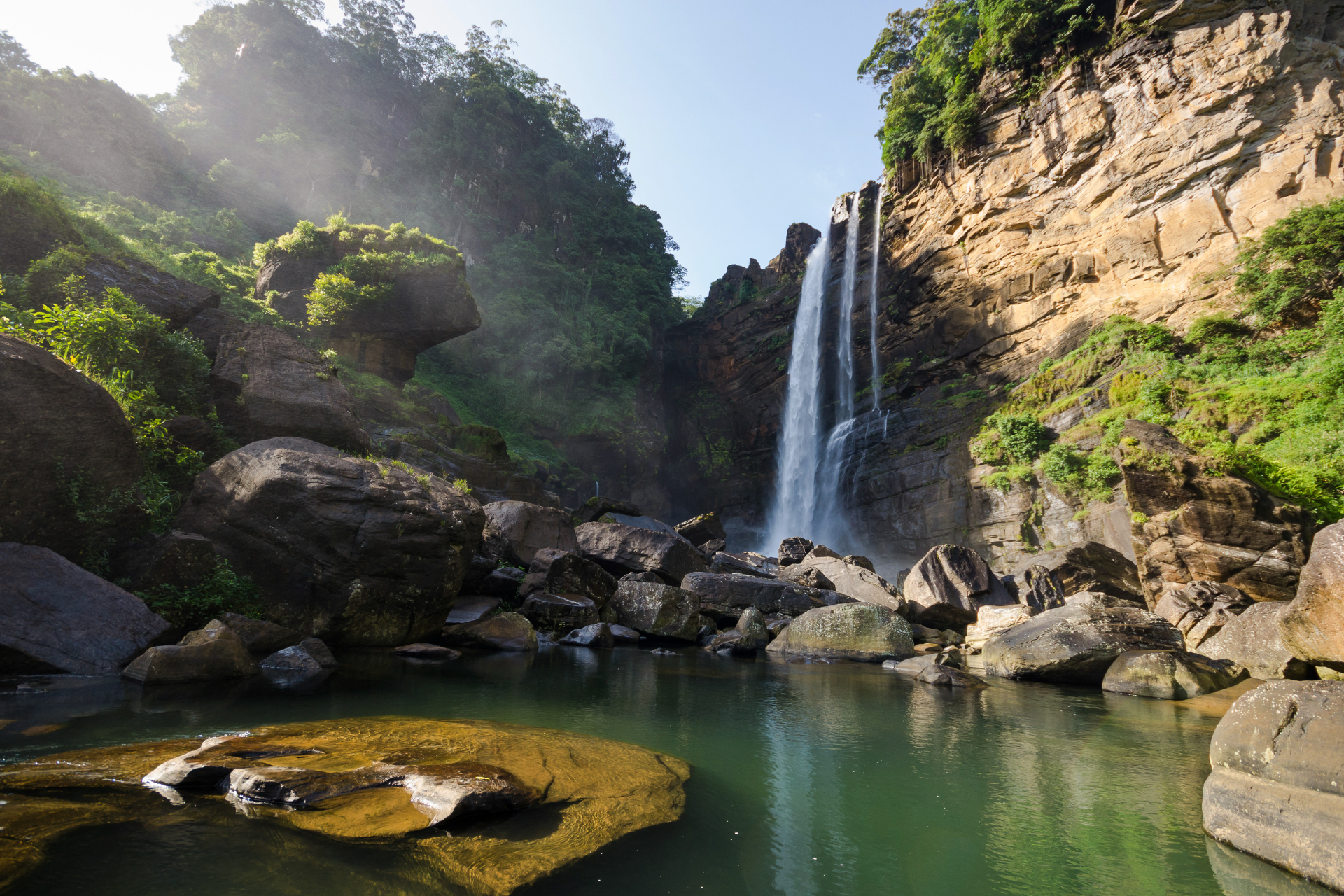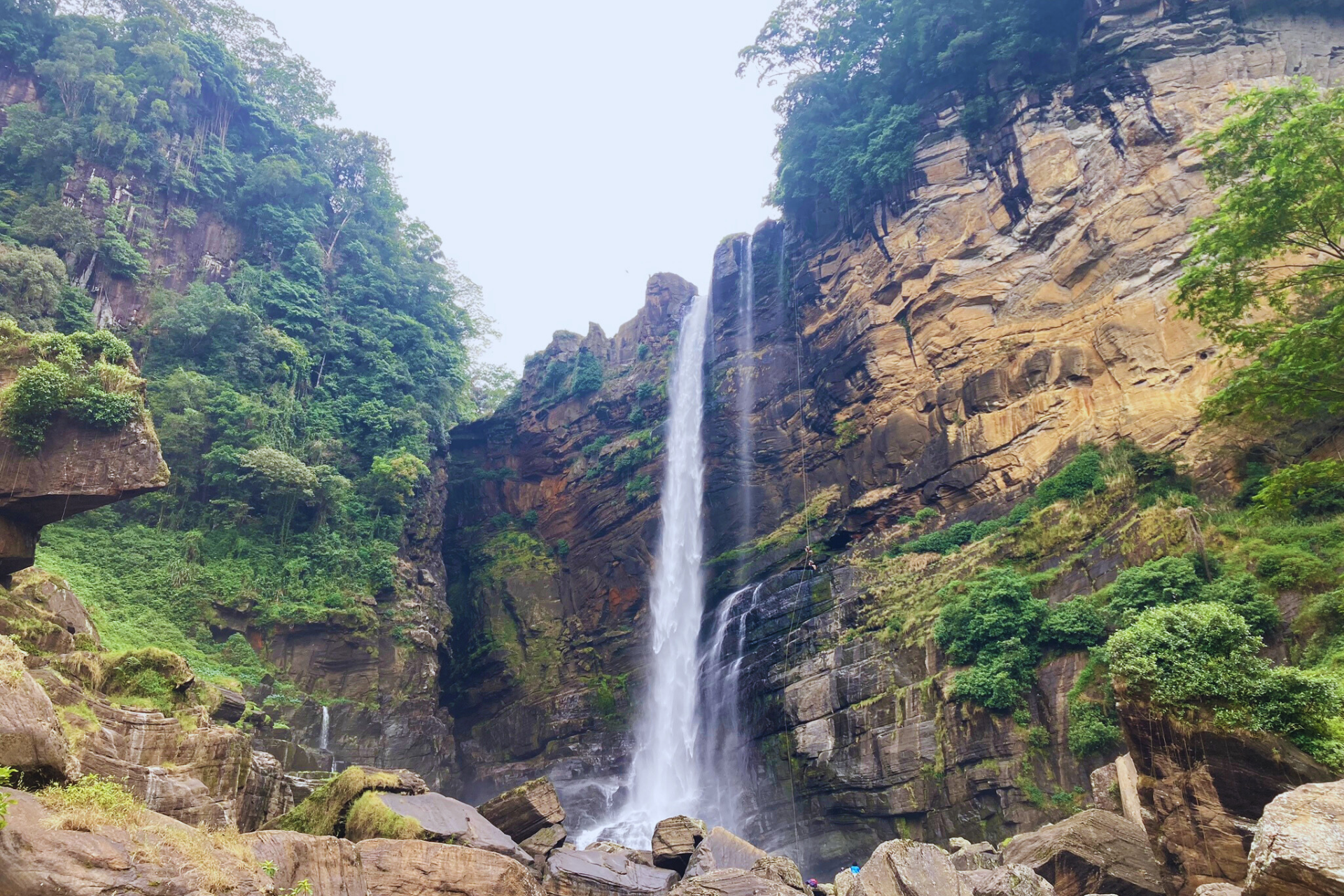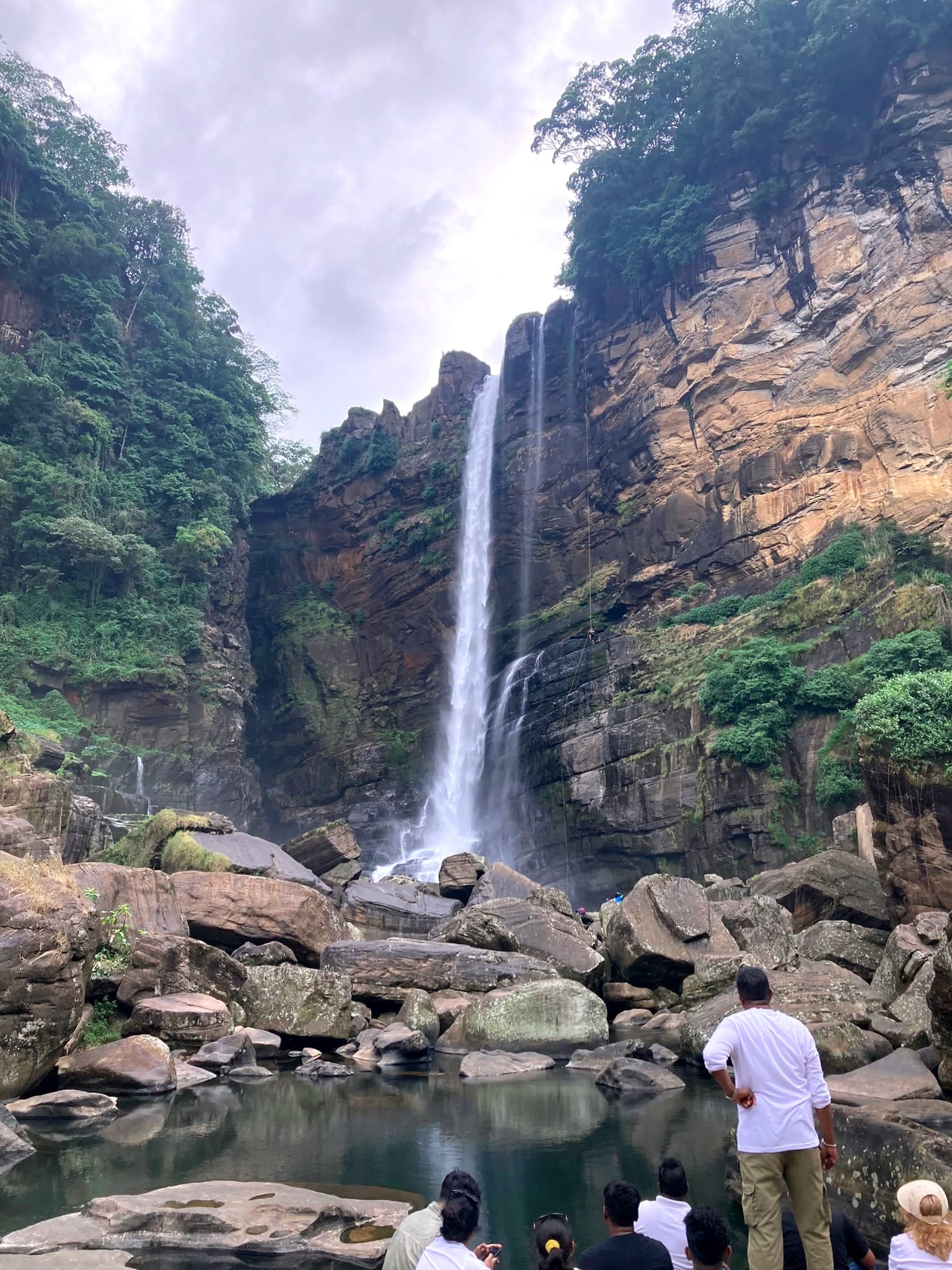
Laxapana Falls
Laxapana Falls is one of Sri Lanka's tallest waterfalls and a popular destination for travelers. Located in a scenic area rich in natural beauty and history, the falls offer a variety of activities for visitors. This travel guide provides essential information to help you plan your visit, including features of the falls, things to do in the area, and practical tips for travelers.
Overview of the Falls
Laxapana Falls is one of Sri Lanka's most significant waterfalls in both stature and impact. With a height of 126 meters, it ranks as the eighth-highest waterfall in the country. The water for the falls is sourced from the Maskeliya Oya, a major tributary of the Kelani River. This tributary itself is fed by the rains and natural springs found in the central highlands, making the falls a year-round spectacle to some degree, although its grandeur varies with the season.
The fall comprises two main sections: a higher and a lower fall. The higher fall is what most people associate with Laxapana, featuring a vertical drop that creates a stunning visual effect. The lower fall, although smaller, complements the higher one and adds to the overall scenic quality of the area.
The waterfall is not just a visual wonder; it's also an essential component of the region’s ecosystem. It serves as a habitat for various forms of aquatic life and impacts the surrounding flora and fauna. The water from the falls eventually joins the Kelani River, one of Sri Lanka's major rivers, which has its own ecological and economic importance.
Adjacent to the falls is a hydroelectric power plant that is crucial to Sri Lanka's electricity grid. Initially constructed in the early 20th century, the plant has seen several upgrades to meet modern energy demands. It currently has a capacity of approximately 50 megawatts, making it a significant player in the region's renewable energy landscape.
Visitors to Laxapana Falls are often taken aback by its raw power, especially during the monsoon season when the water volume significantly increases. Even during the dry season, the falls remain an imposing sight, surrounded by natural forest, rocky terrains, and a misty atmosphere that adds an air of mystery.

Historical Significance
The waterfall has been an integral part of local folklore and culture for generations. Its name, "Laxapana," is believed to be derived from the Sinhalese words "Laksha" and "Pana," meaning "hundred thousand" and "lamp flares," respectively. The hydroelectric power plant near the waterfall has also contributed to the country's industrial growth since the early 20th century.
Features
Height and Volume
Laxapana Falls is among the tallest waterfalls in Sri Lanka, boasting a height of 126 meters. The cascade has a width that varies depending on the season and the water flow. During the monsoon, the width can expand, giving the waterfall an even more imposing appearance. The flow rate also varies but is generally at its peak during the rainy season, which adds to its awe-inspiring aura.
Hydroelectric Power Plant
The hydroelectric plant near Laxapana Falls is an engineering marvel that plays a pivotal role in the country's energy infrastructure. Initially constructed in the early 20th century, the facility has undergone multiple upgrades to keep pace with growing energy demands. The plant currently operates with a capacity of approximately 50 megawatts. The dam associated with the plant also helps in flood control and irrigation, serving multiple functions for the region.
Natural Surroundings
The area around Laxapana Falls is abundant in natural beauty and biodiversity. The forests are home to an array of plant species, including ferns, mosses, and various kinds of trees, which make the environment rich and vibrant.
The fauna is equally diverse, with various mammals such as monkeys and deer often spotted in the vicinity. The region is also a habitat for numerous insects and amphibians, contributing to the ecological importance of the area.
Geological Features
The geological aspects of Laxapana Falls are worth noting. The waterfall flows over several rock formations that are predominantly metamorphic, shaped by natural processes over millions of years. These rocks offer not just a rugged beauty but also provide insight into the geological history of the region.
Accessibility
Laxapana Falls is accessible through well-marked trails, offering options for both amateur and experienced hikers. The trails are generally well-maintained but can get slippery during the rainy season. Accessing the upper point of the Falls is not that hard and manageable for most people. However, accessing the lower point is difficult and may not be suitable for some people as it involves about 500m of stairs.
Exploring the Waterfall
Upper Point
The top of Laxapana Falls is a wide, open area with a large rocky surface. The smooth metamorphic rocks have beautiful extraordinary curved shapes that make them unique. During the dry season, the rocky surface is mostly exposed, and you can walk around freely or sit by the small puddles that form in the grooves. The water flows gently here before the sudden drop, making it a calm and quiet place to relax.
You can dip your feet in the cool water or simply enjoy walking across the rocks. Be cautious, though as some areas can be slippery, especially closer to the edge. Many travelers spend time here relaxing, enjoying the view and taking photos of this scenic setting.
Lower Point
Descending to the lower section brings you face-to-face with a basin-like clearing, framed by jagged rocks, lush greenery, and the thunderous roar of the falls. The atmosphere here is both intimate and awe-inspiring, as if you’ve stumbled into a secret corner of nature’s own design. Small birds often dart around the spray, adding a lively soundtrack of chirps and calls.
If you’re feeling adventurous, you can follow a path closer to the falls—though it’s rugged and potentially treacherous, so a local guide is highly recommended. With their help, you’ll navigate the hidden nooks among the rocks more safely. Standing in this lower point, surrounded by the mist and rushing water, is a moment sure to fill you with wonder and respect for nature’s raw power.

Things to Do Around Laxapana Falls
Waterfall Abseiling
Waterfall abseiling at Laxapana Falls is a thrilling experience for adventure seekers. With the falls standing at an impressive height of 126 meters, adventurers can descend alongside the powerful cascade, secured by ropes and harnesses. Guided by professional instructors, this activity combines the thrill of rappelling with the awe of being up close to the roaring waters. Companies like Rapid Adventures and Thrill Seekers Lanka offer packages for this activity, providing all necessary safety gear and expertise. This activity is perfect for those who crave adrenaline and want a unique way to connect with nature.
Rope Jumping
Rope jumping at Laxapana Falls offers an exhilarating experience similar to bungee jumping. This is the highest rope jump in all of Sri Lanka. Participants leap off a secure platform, tied to a rope system, and swing over the breathtaking scenery surrounding the falls. Organized by groups like The Marvel Sri Lanka, this activity is designed for thrill-seekers looking to push their boundaries. The combination of freefall next to the roaring waterfall creates an unforgettable adventure.
Photography
Laxapana Falls presents multiple opportunities for photography enthusiasts. The cascade, its surrounding forests, and the rich biodiversity offer a variety of subjects. You can take amazing photos from both the upper and lower points of the Falls. Certain points along the hiking trails are also ideal spots for capturing the falls in all its glory. The early morning mist and the golden hours of sunset offer particularly good lighting conditions.
Hiking
The area around Laxapana Falls offers several hiking trails, each with varying levels of difficulty. These trails lead to different viewpoints, some of which provide a full view of both the higher and lower falls. Each trail has its own unique attractions, from smaller streams to rich vegetation. Hiking allows you to experience the natural beauty up close and is a must-do for adventure enthusiasts.
Bird Watching
For birdwatchers, the area around Laxapana Falls is a paradise. Various indigenous bird species inhabit the region. Bring binoculars to make the most of this experience. Early morning is generally the best time for bird watching, as many species are most active during this period.
Swimming
The base of Laxapana Falls has a natural pool where you can enjoy a relaxing swim. The water is cool and offers a pleasant experience, especially after a hike. However, swimming here is advised only for strong swimmers, and even they should exercise extreme caution due to the currents.
Picnicking
The areas surrounding the falls offer suitable spots for a picnic. Many visitors bring a packed lunch to enjoy in the natural setting. If you choose to picnic, remember to clean up after yourself to maintain the area's natural beauty.
Location and How to Get There
Laxapana Falls is located near the town of Maskeliya in the Nuwara Eliya District. It is about 115 kilometers away from Colombo and will take around 4 hours to get there. It is about 30km away from the towns of Hatton and Maskeliya and about 16km from Kitulgala, so you can visit Laxapana Falls during a trip to one of those popular destinations.
The entry points to the upper and lower parts of the falls are situated somewhat close to each other. In both places you will have to park your vehicle and climb down a flight of stairs to reach the waterfall.
Getting to the Upper and Lower Points
- Upper Point: To reach the upper point, park your vehicle near the entrance. A set of stairs leads directly to the rocky surface at the top of the waterfall. While the steps are a bit steep, the climb isn’t long, making it manageable for most people. It’s a relatively easy and quick walk to this viewpoint.
- Lower Point: For the lower point, park near the entrance, where you’ll likely see other vehicles and small shops. From there, you’ll need to descend a longer flight of stairs that winds past houses and through patches of trees. The steps are steep, and the journey is much longer compared to the upper point—about 500 meters in total. Climbing back up can be challenging, so it might be very difficult for some visitors. Be prepared for a workout if you plan to visit the lower point.
Best Time to Visit
The best time to visit Laxapana Falls really depends on what you’re looking for.
- Wet Season (May to November): This is when the falls are at their most powerful and breathtaking. The heavy rains make the surrounding greenery lush and vibrant, creating a dramatic backdrop for the waterfall. However, the trails can get muddy and slippery, and swimming isn’t safe because of the strong currents. Be prepared for sudden rain showers, which might affect your plans.
- Dry Season (December to April): If you prefer a calmer experience, the dry season is ideal. The waterfall is less forceful during this time, but the trails are much easier to navigate, making it great for hiking and exploring. The weather is warm during the day and cool at night, which is perfect for spending time outdoors. While the falls won’t be as dramatic, it’s still a beautiful sight. This is also the better time if you are planning on abseiling or rope jumping.
Tips and Advice
- Safety First: Exercise extreme caution near the falls and the pool area. Follow all posted safety signs and guidelines.
- Footwear: Wear sturdy, non-slip shoes suitable for hiking and navigating slippery surfaces.
- Local Guides: Consider hiring a local guide familiar with the trails and safe swimming spots, which can enhance your experience and safety.
- Weather Check: Before your visit, check the weather forecast. Conditions can change rapidly, and it's good to be prepared.
- Early Arrival: Try to arrive early, especially during weekends or holidays, as the area can get crowded.
- Snacks: Pack some light snacks or energy bars, especially if you plan on spending a lot of time hiking or exploring.
- Photography Gear: If you're into photography, don't forget your camera and any other equipment like tripods or lenses. The natural lighting conditions can vary, so adjustable settings are beneficial.
- Help Protect the Environment: Carry a trash bag to pack out all your waste, and leave the environment as pristine as you found it.
Nearby Attractions
- Adam's Peak: This is one of Sri Lanka's most famous pilgrimage sites. The mountain offers a challenging hike, but the panoramic views from the summit are highly rewarding. The area has religious significance and attracts visitors from various faiths.
- Aberdeen Falls: Located not far from Laxapana Falls, Aberdeen Falls offers a picturesque setting ideal for photography and relaxation.
- Kitulgala: If you're an adrenaline junkie, Kitulgala is the place for you. Known for white-water rafting, the area offers a variety of adventure sports and activities. The Kelani River running through Kitulgala provides the perfect setting for these water-based activities.
- St. Clair's Falls: Often referred to as the "Little Niagara of Sri Lanka," St. Clair's Falls is divided into two sections: "Maha Ella" and "Kuda Ella." Both offer unique scenic beauty, making it a popular stop for tourists. There are viewpoints and tea shops where you can enjoy the view.
- Devon Falls: This waterfall is located along the same highway as St. Clair's Falls and offers another beautiful natural setting. A popular stopover for those traveling in the region, Devon Falls offers excellent photo opportunities and is visible from the main road, making it easily accessible.
Laxapana Falls is not just a destination but an experience that perfectly captures the natural and cultural value of Sri Lanka. A visit here offers an enriching journey that transcends traditional sightseeing, inviting you to engage with both the land and its heritage in a deeply meaningful way.
